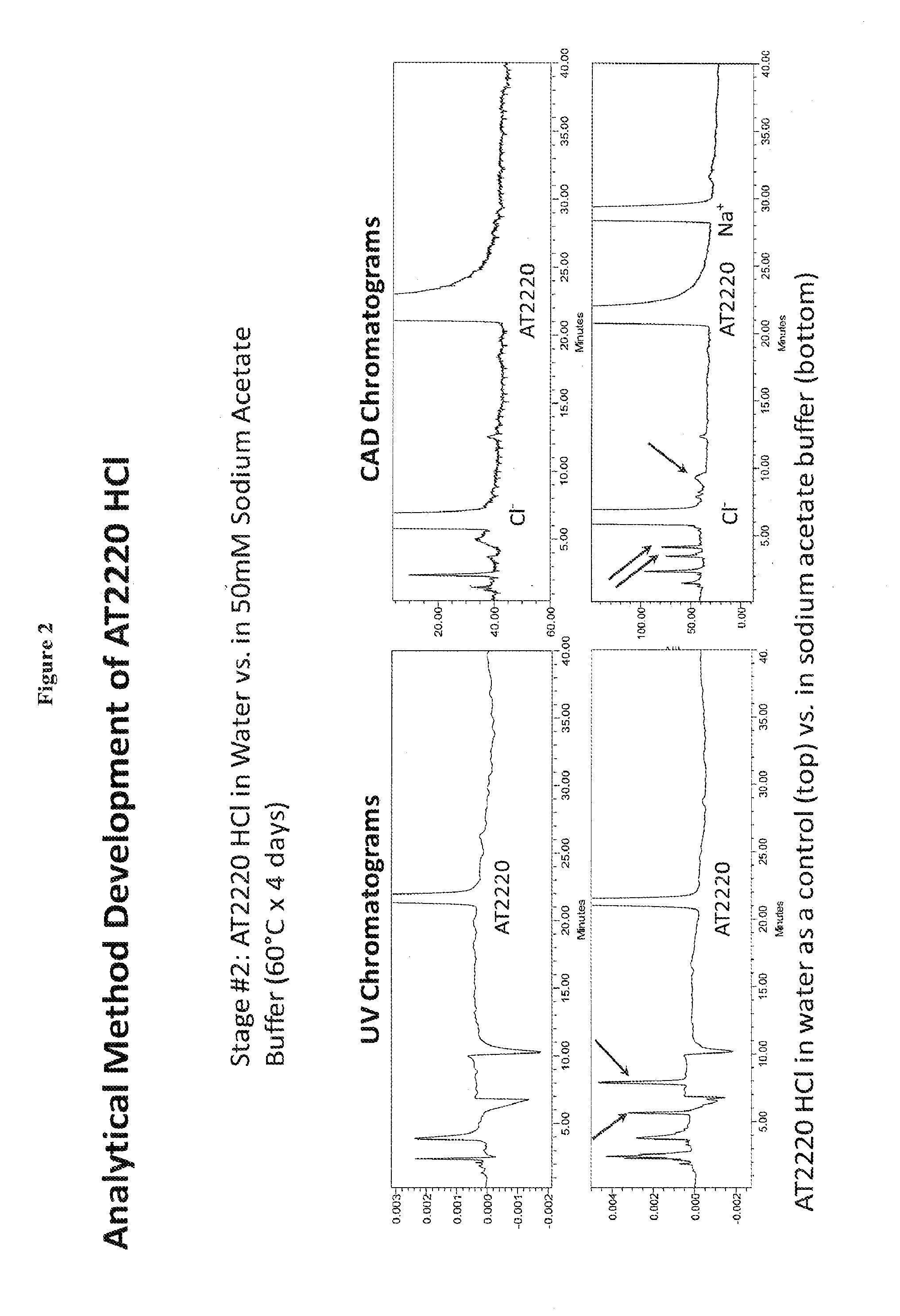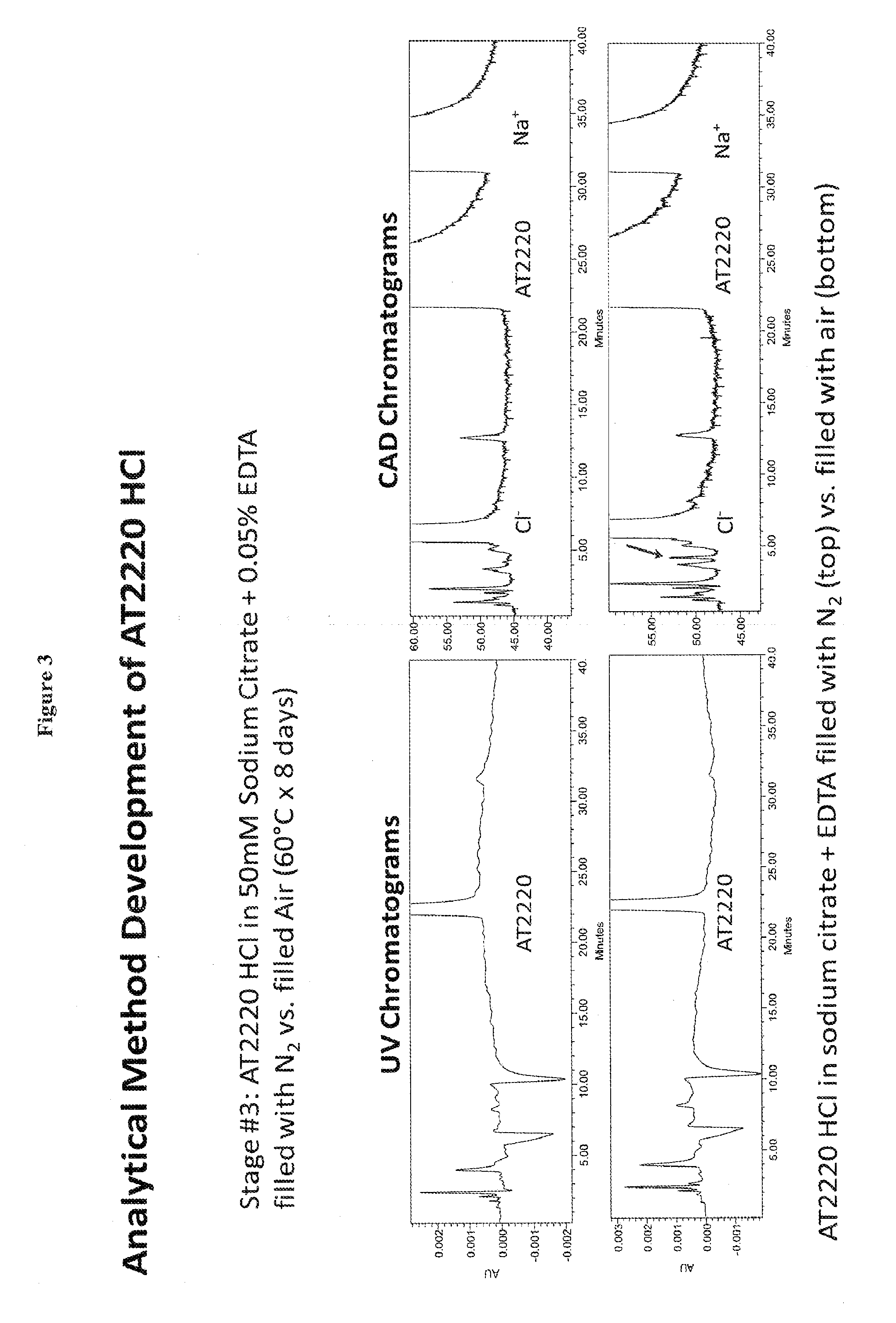Stable parenteral dnj compositions
a parenteral and composition technology, applied in the field of lysosomal storage disorder, can solve the problems of inability to tolerate, difficulty in swallowing, and inability to tolerate, and achieve the effect of avoiding harmful health effects
- Summary
- Abstract
- Description
- Claims
- Application Information
AI Technical Summary
Benefits of technology
Problems solved by technology
Method used
Image
Examples
example 1
Preparation of Buffers
[0034]The following representative buffer compositions were prepared by admixing the ingredients set forth below. The buffers used in Examples 2-6 below were prepared in a similar fashion, amounts of acidic and basic components modified, if necessary, to obtain the pH parameters specified therein.
TABLE 2Components of 50 mM sodium citrate buffer, pH 5ComponentAmount per mlSodium Citrate Dihydrate9.32mgCitric Acid Monohydrate3.85mgWaterq.s. to 1.0mL
TABLE 3Components of 50 mM sodium acetate buffer, pH 5.5ComponentAmount per mlSodium Acetate Trihydrate5.92mgGlacial Acetic Acid0.384mgWaterq.s. to 1.0mL
TABLE 4Components of 100 mM sodium phosphate buffer, pH 7ComponentAmount per mlSodium Phosphate Monobasic Monohydrate4.79mgSodium Phosphate Dibasic, Anhydrous9.26mgWaterq.s. to 1.0mL
[0035]Deionized and / or distilled water can be used in place of water.
example 2
Stability and Integrity of 1-deoxynojirimycin Chloride in 100 mM Sodium Phosphate Buffer Solution
[0036]1-DNJ-HCl was dissolved in sodium phosphate buffer. 1-DNJ-HCl concentration was 60 mg / mL; sodium phosphate buffer concentration was 100 mM at pH 4.89. The formulation was stored at 60° C. for 4 days. 1-DNJ-HCl solution in water was used as a control. Reaction rate for small molecules such as 1-DNJ-HCl generally follows Arrhenius equation where reaction rate nearly doubles for every 10° C. increase in the temperature. Thus, under this model, the reaction rate at 60° C. would be 25 or 32 times the reaction rate at 10° C. Therefore during 4 days at 60° C. 1-DNJ-HCl would degrade by approximately the same percentage as during 128 days (4*32) at 10° C.
[0037]The stability of 1-DNJ-HCl was measured by normal phase high performance liquid chromatography (NP-HPLC). 1-DNJ-HCl was recorded by UV chromatograms and by Charged Aerosol Detector (CAD) chromatograms. Mobile phase consisted of ACN / 3...
example 3
Stability and Integrity of 1-deoxynojirimycin Chloride in 50 mM Sodium Acetate Buffer Solution
[0040]1-DNJ-HCl was dissolved in sodium acetate buffer. The 1-DNJ-HCl concentration was 60 mg / mL; sodium acetate buffer concentration was 50 mM at pH 5.5. The formulation was stored at 60° C. for 4 days. 1-DNJ-HCl solution in water was used as control. Reaction rate for small molecules such as 1-DNJ-HCl generally follows the Arrhenius equation, in which the reaction rate nearly doubles for every 10°K increase in the temperature. Thus the reaction rate, under this model, at 60° C. would be 25 or 32 times the reaction rate at 10° C. Therefore during 4 days at 60° C. 1-DNJ-HCl would degrade by approximately same percentage as during 128 days at at 10° C.
[0041]The stability of 1-DNJ-HCl was measured by NP-HPLC. Presence of 1-DNJ-HCl was recorded by UV absorbance detector and by Charged Aerosol Detector. Mobile phase consisted of ACN / 30 mM Ammonium Acetate (90 / 10, v / v). The flow rate was 1.0 ml / ...
PUM
| Property | Measurement | Unit |
|---|---|---|
| Temperature | aaaaa | aaaaa |
| Temperature | aaaaa | aaaaa |
| Temperature | aaaaa | aaaaa |
Abstract
Description
Claims
Application Information
 Login to View More
Login to View More - R&D
- Intellectual Property
- Life Sciences
- Materials
- Tech Scout
- Unparalleled Data Quality
- Higher Quality Content
- 60% Fewer Hallucinations
Browse by: Latest US Patents, China's latest patents, Technical Efficacy Thesaurus, Application Domain, Technology Topic, Popular Technical Reports.
© 2025 PatSnap. All rights reserved.Legal|Privacy policy|Modern Slavery Act Transparency Statement|Sitemap|About US| Contact US: help@patsnap.com



